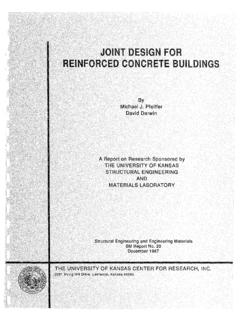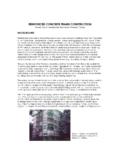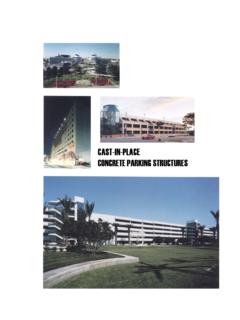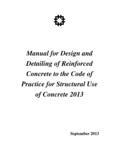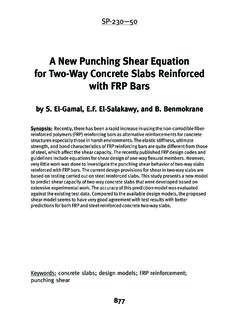Transcription of PRECAST CONCRETE STRUCTURES - paradigm
1 Structural Engineering & Geospatial ConsultantsPRECAST CONCRETE concept of PRECAST (also known as prefabricated ) construction includesthose buildings, where the majority of structural components are standardized andproduced in plants in a location away from the building, and then transported to the sitefor assembly. These components are manufactured by industrial methods based on massproduction in order to build a large number of buildings in a short time at low Engineering & Geospatial ConsultantsThe main features of this construction process are as follows.
2 The division and specialization of the human workforce The use of tools, machinery, and other equipment, usually automated, in theproduction of standard, interchangeable parts and products Compared to site-cast CONCRETE , PRECAST CONCRETE erection is faster and lessaffected by adverse weather conditions. Plant casting allows increased efficiency, high quality control and greater controlon type of construction requires a restructuring of entire conventional constructionprocess to enable interaction between design phase and production planning in order toimprove and speed up TYPES OF PRECAST SYSTEMSD epending on the load-bearing structure , PRECAST systems can be divided into the followingcategories.
3 Large-panel systems Frame systems Slab-column systems with walls Mixed systemsStructural Engineering & Geospatial Consultants1. 1. 1 LARGE PANEL SYSTEMSThe designation large-panel system refers to multistory STRUCTURES composed oflarge wall and floor CONCRETE panels connected in the vertical and horizontal directions sothat the wall panels enclose appropriate spaces for the rooms within a building. Thesepanels form a box-like structure . Both vertical and horizontal panels resist gravity panels are usually one story high. Horizontal floor and roof panels span either asone-way or two-way slabs.
4 When properly joined together, these horizontal elementsact as diaphragms that transfer the lateral loads to the on wall layout , there are three basic configurations of large-panel buildings: Cross-wall systems Longitudinal wall systems Two-way systemsA large-panel CONCRETE building under constructionStructural Engineering & Geospatial Consultants1. 1. 2 FRAME SYSTEMSP recast frames can be constructed using either linear elements or spatial beam-column sub-assemblages. PRECAST beam-column sub-assemblages have the advantage thatthe connecting faces between the sub-assemblages can be placed away from the criticalframe regions; however, linear elements are generally preferred because of thedifficulties associated with forming, handling, and erecting spatial elements.
5 The use oflinear elements generally means placing the connecting faces at the beam-columnjunctions. The beams can be seated on corbels at the columns, for ease of constructionand to aid the shear transfer from the beam to the column. The beam-column jointsaccomplished in this way are hinged. However, rigid beam-column connections are used insome cases, when the continuity of longitudinal reinforcement through the beam-columnjoint needs to be ensured. The components of a PRECAST reinforced CONCRETE frame areshown in FigureStructural Engineering & Geospatial Consultants1.
6 1. 3 SLAB-COLUMN SYSTEMS WITH SHEAR WALLST hese systems rely on shear walls to sustain lateral load effects, whereas theslab-columnstructure resists mainly gravity loads. There are two main systems in this category: Lift-slab system with walls Prestressed slab-column systemIn the Lift slab system, the load-bearing structure consists of precastreinforced CONCRETE columns and slabs,. PRECAST columns are usually two stories high. Allprecast structural elements are assembled by means of special joints. Reinforcedconcrete slabs are poured on the ground in forms, one on top of the other.
7 Precastconcrete floor slabs are lifted from the ground up to the final height by lifting slab panels are lifted to the top of the column and then moved downwards to thefinal position. Temporary supports are used to keep the slabs in the position until theconnection with the columns has been lift-slab buildingStructural Engineering & Geospatial ConsultantsThe prestressed slab-column system uses horizontal prestressing in twoorthogonal directions to achieve continuity. The PRECAST CONCRETE column elements are 1to 3 stories high.
8 The reinforced CONCRETE floor slabs fit the clear span betweencolumns. After erecting the slabs and columns of a story, the columns and floor slabs areprestressed by means of prestressing tendons that pass through ducts in the columns atthe floor level and along the gaps left between adjacent slabs. After prestressing, thegaps between the slabs are filled with in situ CONCRETE and the tendons then becomebonded with the spans. Seismic loads are resisted mainly by the shear walls ( PRECAST orcast-in-place) positioned between the columns at appropriate slab-column connectionStructural Engineering & Geospatial Consultants2.
9 PRECAST CONCRETE STRUCTURAL Beam & GirdersHollow core slabsStructural Engineering & Geospatial WallsInverted Tee beams supported on PRECAST columnsPrecast columnsStructural Engineering & Geospatial StairsUniquely shaped structural elements for a sports stadiumStructural Engineering & Geospatial ConsultantsDESIGN CONCEPTS FOR PRECAST CONCRETE BUILDINGSThe design concept of the PRECAST buildings is based on the buildability,economy and standardization of PRECAST Engineering & Geospatial ConsultantsIn design of PRECAST members and connections, all loading and restraint conditions fromcasting to end use of the structure should be considered.
10 The stresses developed in precastelements during the period from casting to final connection may be more critical than the serviceload stresses. Special attention should be given to the methods of stripping, storing,transporting, and erecting PRECAST PRECAST members are incorporated into a structural system, the forces anddeformations occurring in and adjacent to connections (in adjoining members and in the entirestructure) should be considered. The structural behavior of PRECAST elements may differsubstantially from that of similar members that are monolithically cast in place.

